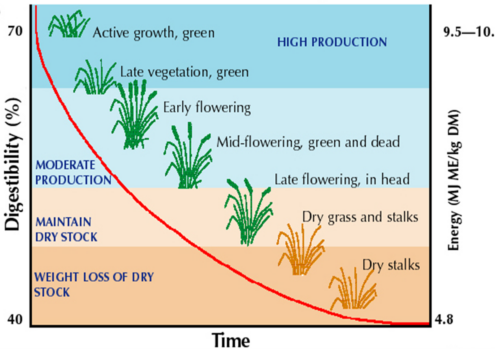The double whammy effect of dry season nutrition
At this time of year, not only is nutrient content of pasture declining, so too is pasture digestibility, resulting in cattle eating much less pasture. This double whammy effect compounds the nutritional challenges cattle face during the dry season, often resulting in an animal’s nutritional requirements not being met. So why is this?
1. Age increases, quality decreases
As grass transitions through its growth phases, the cell structure of the plant changes, with protein and metabolisable energy levels decreasing as the cell wall thickens and starts to lignify. By this time in the season, and in particular this year, most native pastures will have hayed off, indicating they are in phase four, where you could expect the protein and metabolisable energy levels to be very low (Figure 1).

2. Maturity = stiffer cell walls, harder to digest
The increase in lignin content of the grass, reduces digestibility. This is the real kicker, because as digestibility decreases, feed intake decreases, as it takes longer for the animal to digest the feed.
In the dry season, not only is the pasture poorer quality, cattle are eating less of it!
The example below shows that a 400 kg pregnant cow in her third trimester, grazing Phase four pasture, would need to consume 17.5 kg of dry matter per day to meet her maintenance requirement of 525 g protein/day. Due to the low digestibility, she will only consume around 6.8kg of dry matter, leaving large protein and energy deficits.

This double whammy effect of poor pasture quality and reduced intakes poses a significant nutritional challenge most years. To maintain cattle condition, health, and your business profitability, it is crucial to implement a practical and cost-effective strategy that will fill the large nutrient gap that we inevitably experience at the end of every dry season.
Want to hear more?
Come along to one of our Sensible Supplementation workshops to discuss it with your local extension officer.
- Tues 10th Oct – Greenvale
- Wed 11th Oct – Pentland
- Thurs 12th Oct – Belyando
- Friday 13th Oct – Alpha